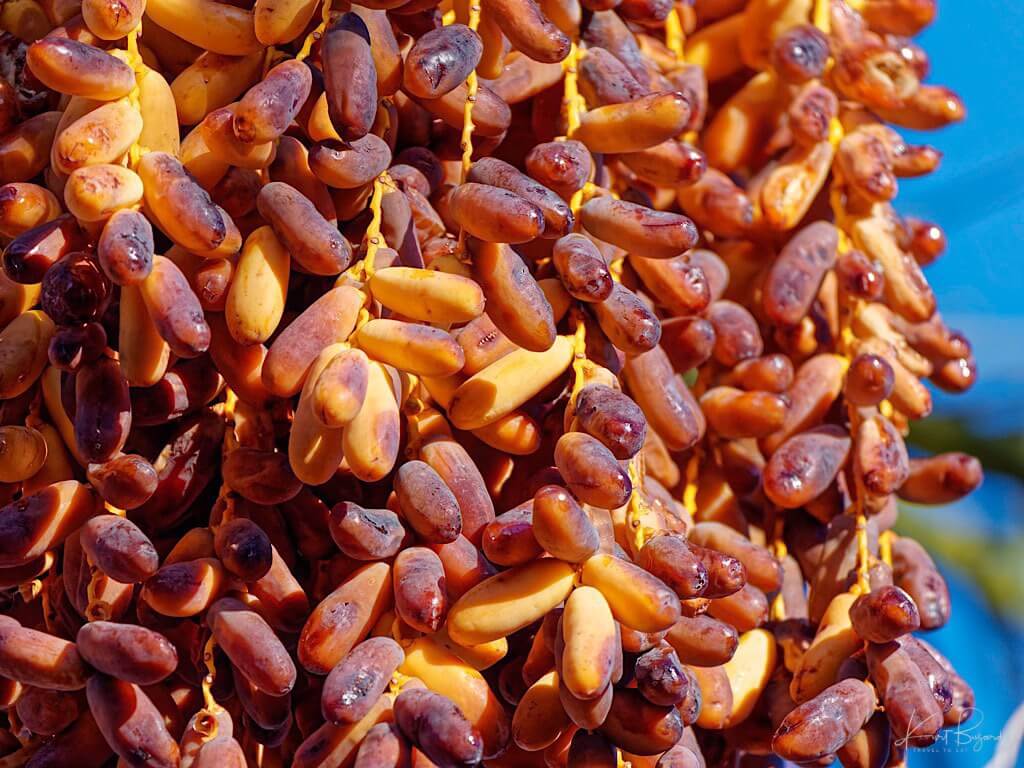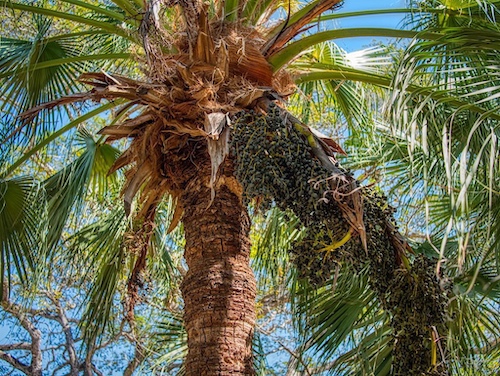
Over the past few years I have accumulated photos of fruit on palm trees and thought that I would bring them together into a single post. Members of the family Arecaceae, palm trees are an ancient and diverse group of trees that bear fruit containing one or multiple seeds. Surprisingly there are a lot of palms commonly harvested for their fruits, and some are hugely important to both local populations and economies throughout the world. Palms represent the third most important plant family with respect to human use. Numerous edible products are obtained from palms, including the familiar date palm fruits, coconut palm nuts, and various palm oils. Some less well-known edible palm products include palm “cabbage” or “heart-of-palm”, immature inflorescences/flowers and sap from mature inflorescences/flowers. It takes palms anywhere from three to 40 years, depending on the species, to flower for the first time. Palm trees have separate male and female flowers. Most of the time they are monoecious, with male and female flowers on the same plant, and sometimes, as in the date palm, the male and female flowers are on separate trees (dioecious).
Plant Reproduction
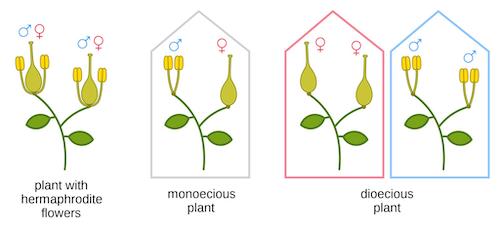
A “perfect” flower has both stamens and carpels, and may be described as “bisexual” or “hermaphroditic”. A “unisexual” flower is one in which either the stamens or the carpels are missing, vestigial or otherwise non-functional. Each flower is either “staminate” (having only functional stamens) and thus “male”, or “carpellate” (or “pistillate”) (having only functional carpels) and thus “female”. If separate staminate and carpellate flowers are always found on the same plant, the species is called monoecious. If separate staminate and carpellate flowers are always found on different plants, the species is called dioecious.
Coconut Palms

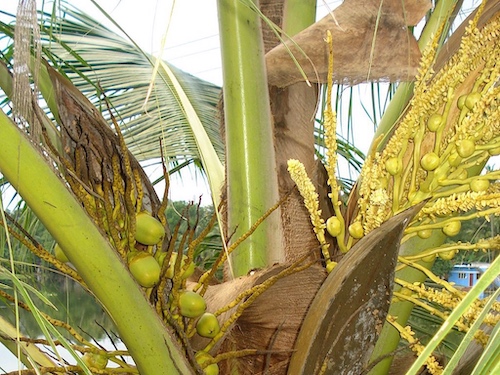
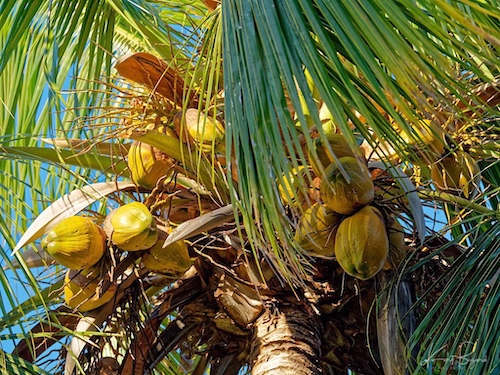
The Coconut palm is monoecious because both male and female flowers are borne on the same plant. Coconut, a palm with multiple uses and known by the producing communities as the “tree of life”, has been supporting the livelihoods of approximately 20 million workers around the globe. Many varieties of coconuts are being cultivated in many countries. These vary by the taste of the coconut water and color of the fruit, as well as other genetic factors. Coconut is a staple nutritional resource for communities, in the form of products such as milk, cream, oil and coconut juice. Numerous products are produced from the coconuts which grow on the trees – coconut milk, coconut oil (worldwide 3.3 million tons), coconut fibers (for rope, mats, brushes and mattresses) and cocopeat. Coconut oil is about 90% saturated fat, which is a higher percentage than butter (about 64% saturated fat), beef fat (40%), or even lard (also 40%). Too much saturated fat in the diet is unhealthy because it raises “bad” LDL cholesterol levels, which increases the risk of heart disease. But what’s interesting about coconut oil is that it also gives “good” HDL cholesterol a boost. Fat in the diet, whether it’s saturated or unsaturated, tends to nudge HDL levels up, but coconut oil seems to be especially potent at doing so. The bottom line is coconut oil can be used in moderation as part of your fat intake but the effect on heart health is unclear.
Coconut Foods and Products
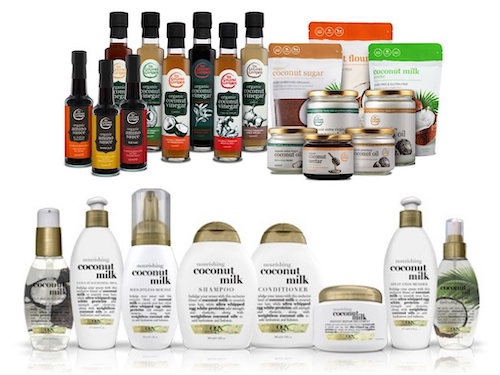
Virgin coconut oil comes from fresh coconut meat and refined coconut oil is made from dried coconut meat called copra. Coconut oil is very suitable for cooking, baking and frying, since it has a moderate smoking point of 350 degrees. Coconut milk and coconut creme are made with ground coconut and water, great for curries and deserts. When coconut oil and coconut meat are ground together, they form a peanut butter-like paste called coconut butter (also known as coconut manna). Coconut flour is made from grinding the dried coconut meat, coconut flour has a fine, soft texture. Coconut flour is so absorbent that you only need 1/4 to 1/3 coconut flour for every 1 cup of wheat or grain flour. Coconut sugar actually comes from the sap of the coconut palm. Coconut oil is also a popular ingredient in beauty products such as soap, moisturizers and shampoo.
Copra
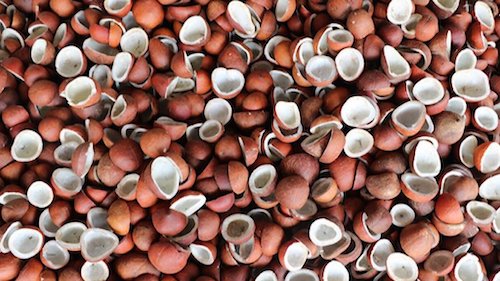
Copra is the dried meat or kernel of the coconut, which is the fruit of the coconut palm (Cocos nucifera). Coconut oil is extracted from copra, making it an important agricultural commodity for many coconut-producing countries. It also yields de-fatted coconut cake/meal after oil extraction, which is mainly used as feed for livestock. Coconut oil can be extracted using either mechanical expellers or solvents (hexane). If you want a product with the most flavor, look for jars labeled virgin. That means it’s made with a press which will help it keep more of its tropical taste. Hexane is toxic and some studies have found adverse reactions with both coconut oil and copra meal when hexane extraction was used. Mechanically expelled copra meal is of higher feeding value, because it contains typically 8–12% oil, whereas the solvent-extracted copra meal contains only 2–4% oil. Premium quality copra meal can also contain 20–22% crude protein. Unfortunately, copra is highly susceptible to the growth of molds and their production of aflatoxins if not dried properly. Aflatoxins can be highly toxic, and are among the most potent known natural carcinogens, particularly affecting the liver. Aflatoxins in copra cake, fed to animals, can be passed on in milk or meat, leading to human illnesses.
Coconut Coir
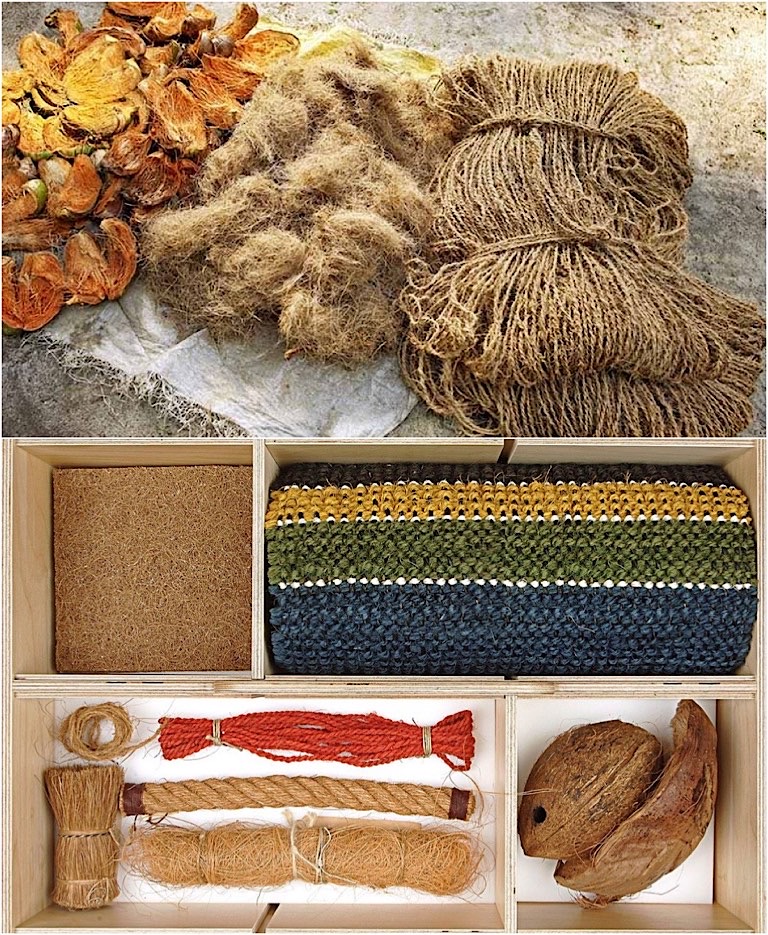
Coir or coconut fiber, is a natural fiber extracted from the husk of coconut and used in products such as floor mats, doormats, brushes and mattresses. Coir is the fibrous material found between the hard, internal shell and the outer coat of a coconut. Other uses of brown coir (made from ripe coconut) are in upholstery padding, sacking and peat for horticulture. White coir, harvested from unripe coconuts, is used for making finer brushes, string, rope and fishing nets. Ropes and cordage have been made from coconut fiber since ancient times. Indian navigators who sailed the seas to Malaya, Java, China, and the Gulf of Arabia centuries ago used coir for their ship ropes. Arab writers of the 11th century AD referred to the extensive use of coir for ship ropes and rigging.
Date Palms
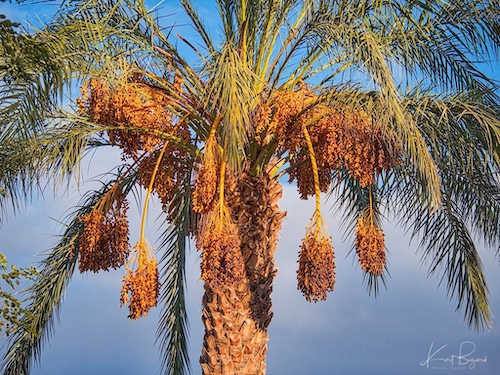
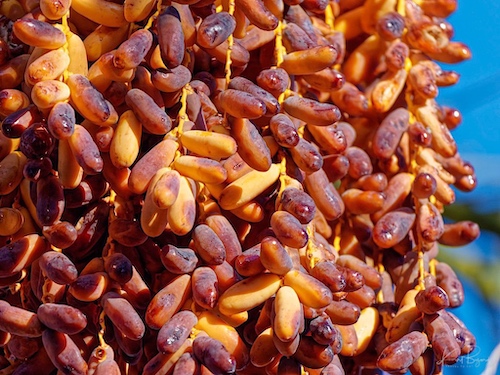
The Date Palm is probably the most well known fruit of palms and is dioecious, with male and female plants. Dates are mentioned more than 50 times in the Bible and 20 times in the Qur’an. Although its exact place of origin is uncertain because of long cultivation, it probably originated from the Fertile Crescent region straddling between Egypt and Mesopotamia. The species is widely cultivated across Northern Africa, the Middle East, The Horn of Africa and South Asia, and is naturalized in many tropical and subtropical regions worldwide. In Las Vegas they are commonly grown as ornamentals and the delicious dates are either given to the gardeners or thrown away. Dates have been a staple food of the Middle East and the Indus Valley for thousands of years. There is archaeological evidence of date cultivation in Arabia from the 6th millennium BCE. A date palm cultivar, probably what used to be called Judean Date Palm, is renowned for its long-lived orthodox seed, which successfully sprouted after accidental storage for 2000 years.
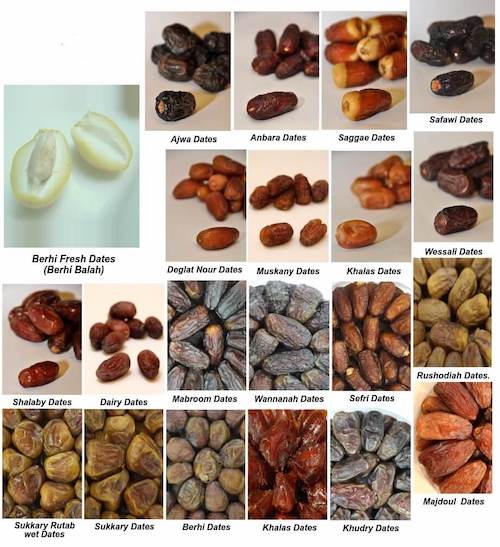
There are many, many cultivars and the dates are sold either fresh or at various stages of drying. The large, sweet and succulent Medjool from Morocco is commonly grown in the United States, Israel, Saudi Arabia, South Africa, Jordan, and United Arab Emirates. Dates provide a wide range of essential nutrients, and are a very good source of dietary potassium. The sugar content of ripe dates is about 80%; the remainder consists of protein, fiber, and trace elements including boron, cobalt, copper, fluorine, magnesium, manganese, selenium, and zinc. Young date leaves are cooked and eaten as a vegetable, as is the terminal bud or heart, though its removal kills the palm. The finely ground seeds are mixed with flour to make bread in times of scarcity. The flowers of the date palm are also edible. Traditionally the female flowers are the most available for sale and weigh a little less than a pound (11–14 oz). The flower buds are used in salad or ground with dried fish to make a condiment for bread.
Canary Island Date Palm

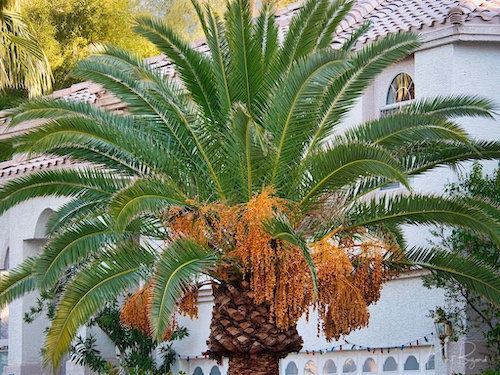
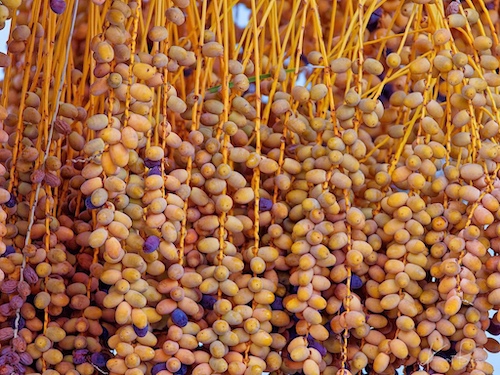
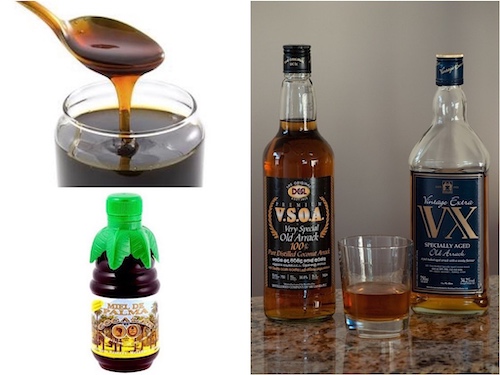
The Canary Island palm is used as a decorative plant and is a favorite of landscape designers. It is a dioecious species, which means that the specimens are either male or female. The Canary Island Date Palm does produce edible dates but they’re so small and their flesh is so thin that few bother to eat them, most of the date is the seed. Phoenix canariensis can grow up to 60 feet tall, and the trunk is often trimmed leaving a section on the top giving rise to the name “Pineapple Palm” as seen above. They have thick trunks and grow slowly. Pulp can also be extracted from the fruit of the Canary Island date palm. The pulp is processed into palm syrup which is known as Miel de Palma. It is used for pastries, pancakes, and ice creams. The flavor of the syrup is like molasses, hence it is used as a drizzling or a dressing for many sweet dishes. The sap is often also converted into an alcoholic drink known as the Arrack, which is very similar to rum. It is also sometimes used for medical purposes.
Mediterranean Dwarf Palm
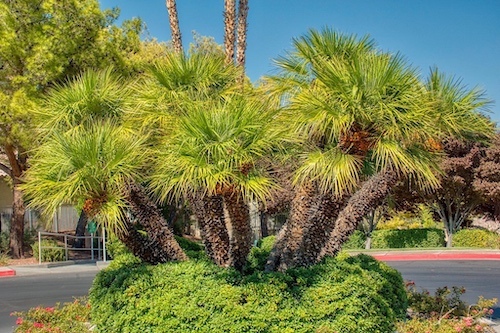
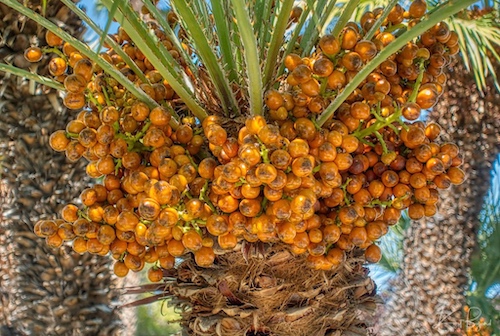
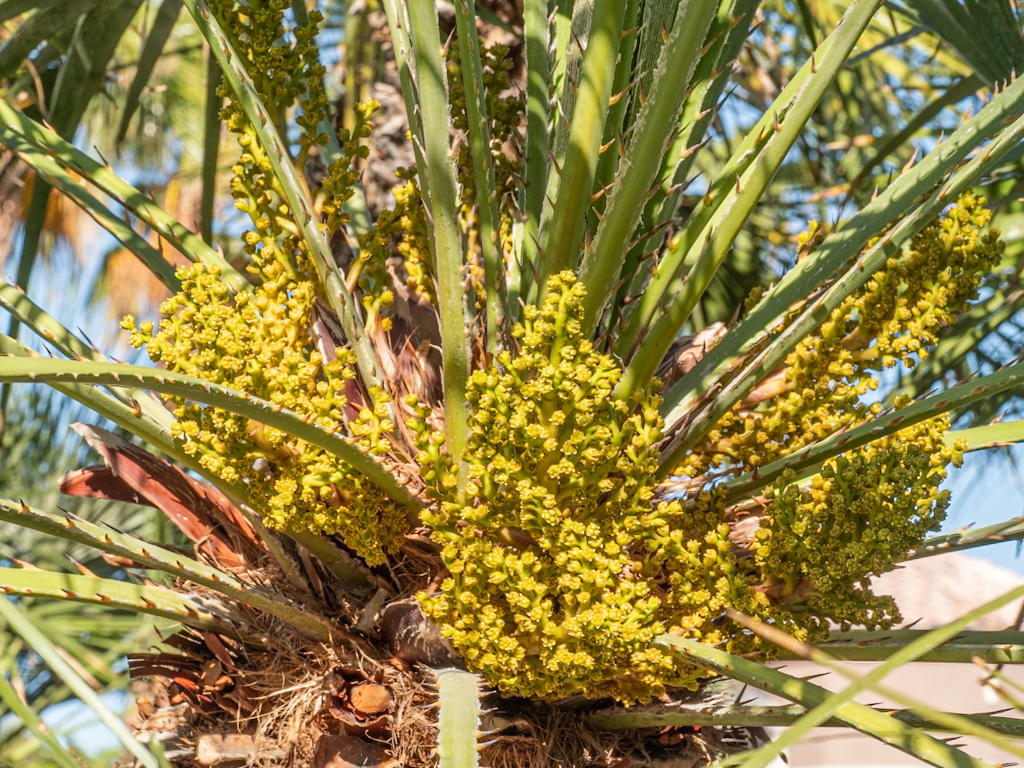
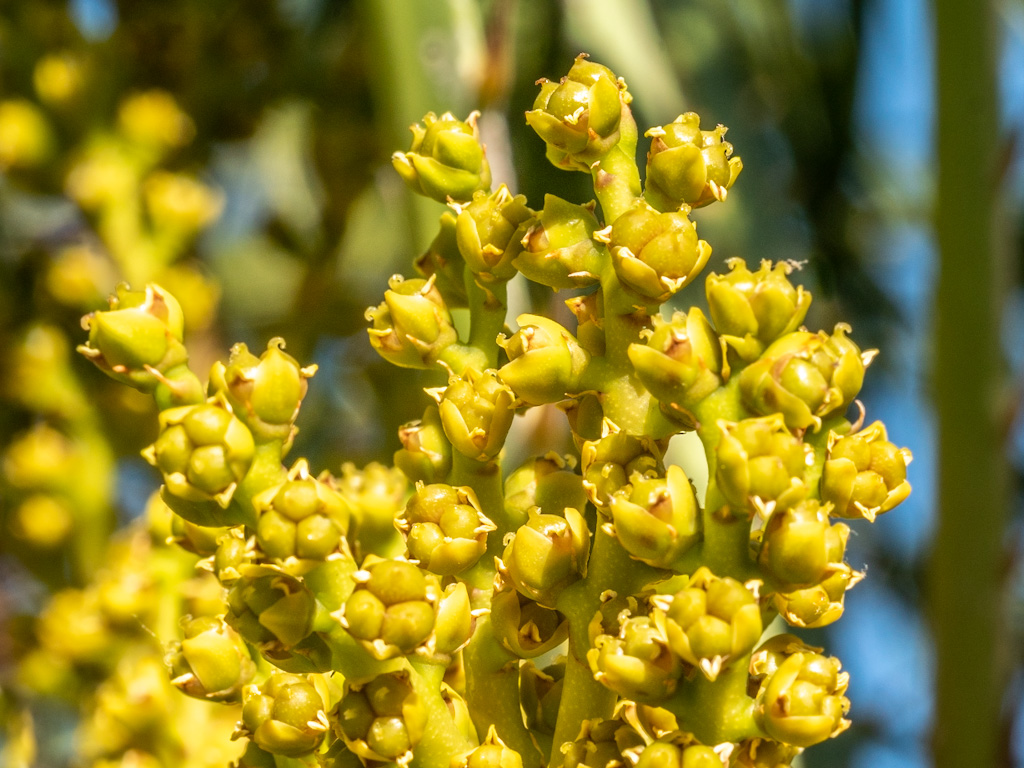
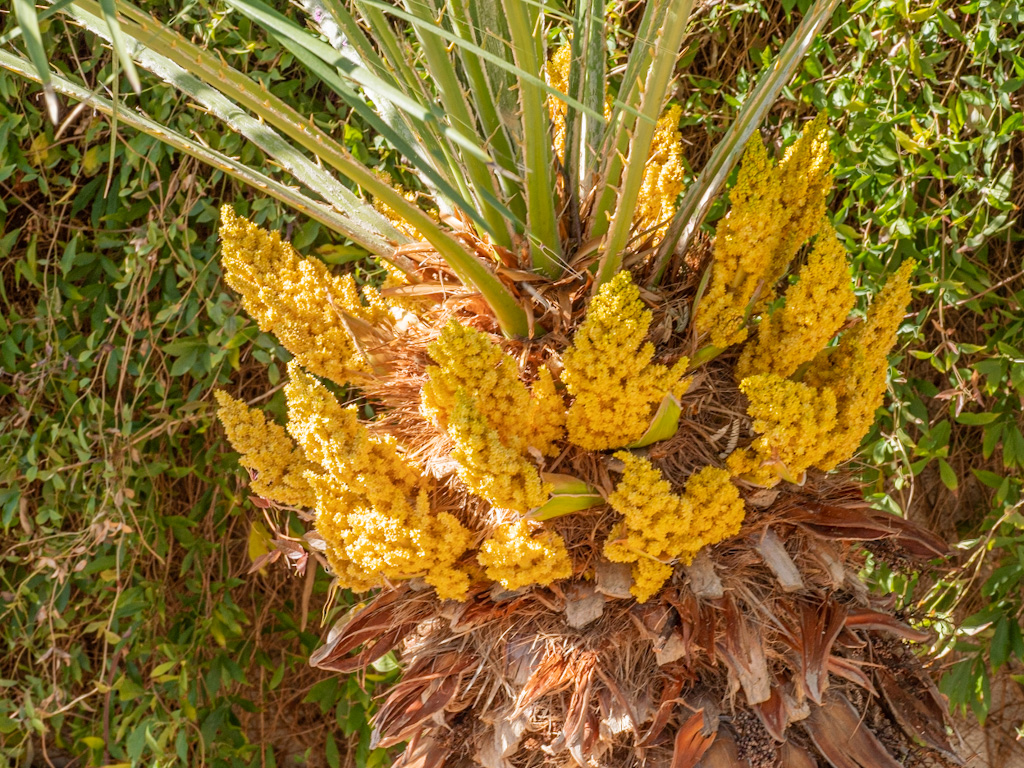
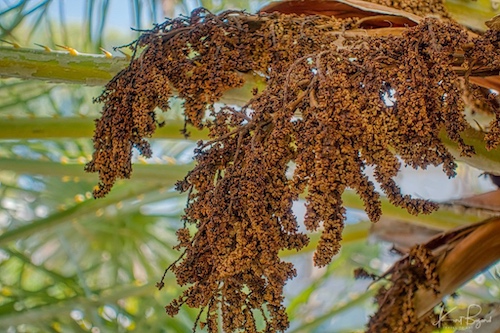
The Mediterranean Dwarf Palm is a shrub-like clumping palm, with several stems growing from a single base. It grows very slowly and is a dioecious species, which means that the specimens are either male or female. It is mainly found in southwestern Europe (Malta, Sicily, Sardinia, over all the Mediterranean coast of Spain and Portugal, central and southern Italy, some parts of the southern Mediterranean coast of France and Monaco, as well as northwest Africa (Morocco, Algeria, Tunisia). Only one insect species is known to pollinate it, namely a specific weevil, Derelomus chamaeropsis. This weevil reproduces only in the male flowers. Very young leaf buds are cooked as a vegetable. The young shoots or suckers from the bottom of the plant are also used. When ripened, the fruit pulp smells strongly of rancid butter and thus acts as a foraging cue for nocturnal carnivorous animals such as badgers and foxes. The husk, known in southern Spain as “higa”, is edible before it becomes too tough to eat as it matures. Because of their bitterness and high tannin content, the fruit are not used for human food, but in traditional medicine they have been used as an astringent. The leaves of the adult plants have been used to make brooms and for weaving mats, carrier baskets, and similar articles. For finer work the young, unopened leaves are treated with sulphur to soften them and provide supple fiber.
Mexican Fan Palm
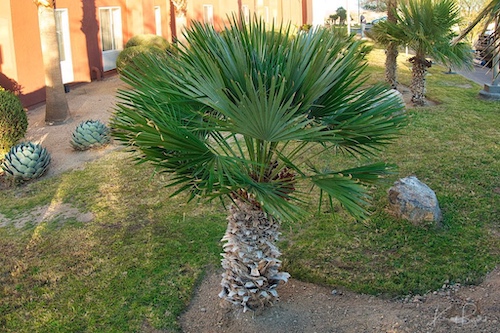
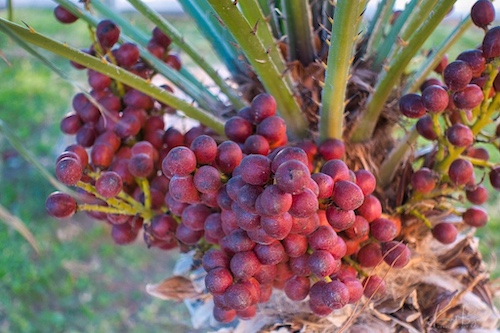
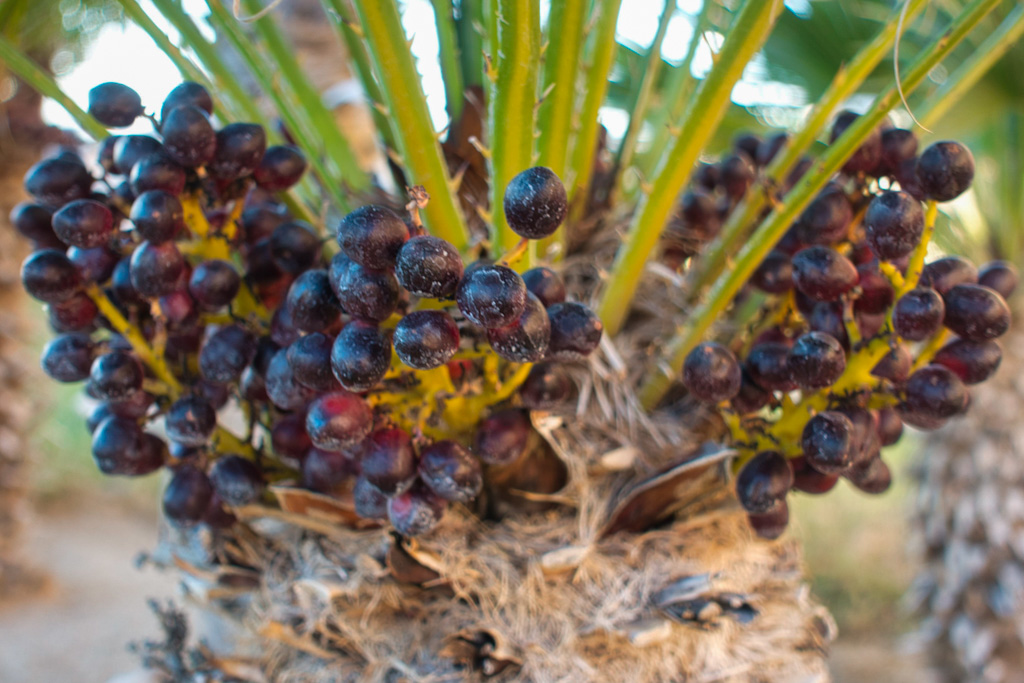
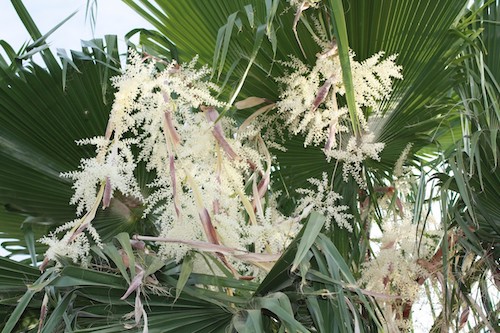
The Mexican fan palm, is perhaps one of the most commonly planted palm trees around the world, and yet in its native home in northern Mexico it is limited to a relatively few water canyons scattered here and there in Sonora and Baja California. Rows of it’s dizzyingly tall, slender trunks topped with a relatively small crown of fronds are the icons of southern California’s older neighborhoods and Hollywood. In spring and early summer long sprays of tiny white flowers are produced on hanging branched flower stalks that grow beyond the limit of the crown, each extending up to 3 meters in length. Unusually for a palm, it has “perfect” flowers with male and female parts in the same flower. By the fall thousands of small dark purple-brown fruits are produced on them.
California Palm

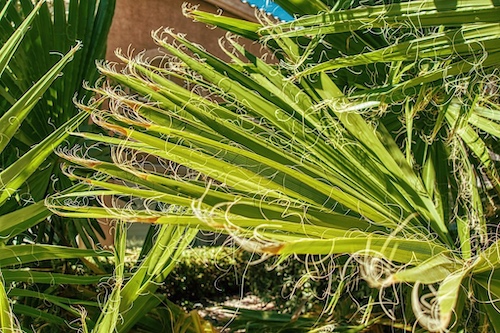
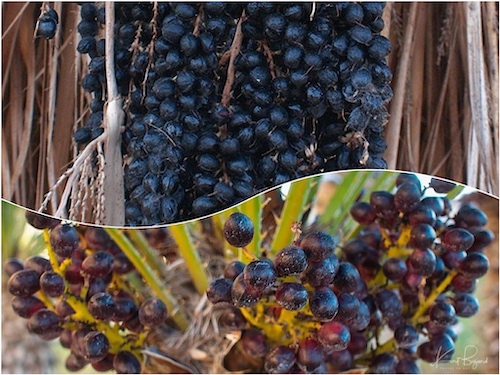
The easiest way to tell a California Palm from a Mexican Fan Palm is by the white filaments on the leaves, hence the scientific name “filifera” (Latin for filament). The California palm is also much more robust when it comes to cold and has a thicker trunk. The California and Mexican fan palms produce very similar if not identical flowers and fruit. The California fan palm was an important resource for the Cahuilla Indians of Southern California, who called it maul. They used it for food, especially the fruit/nut which they ground up as flour or made into a mush. They also soaked the fruits to produce a sweet beverage and made jelly from the fruit. The spongy pith in the center was sometimes boiled and eaten and was called maul pasun or “heart of the palm.” The fan palm was also used for construction (fronds for roof thatch), and leaves were stripped and used in various weaving applications. The original California fan palm oases were important gathering and habitation sites and were indicative of important springs.
Wine Palm
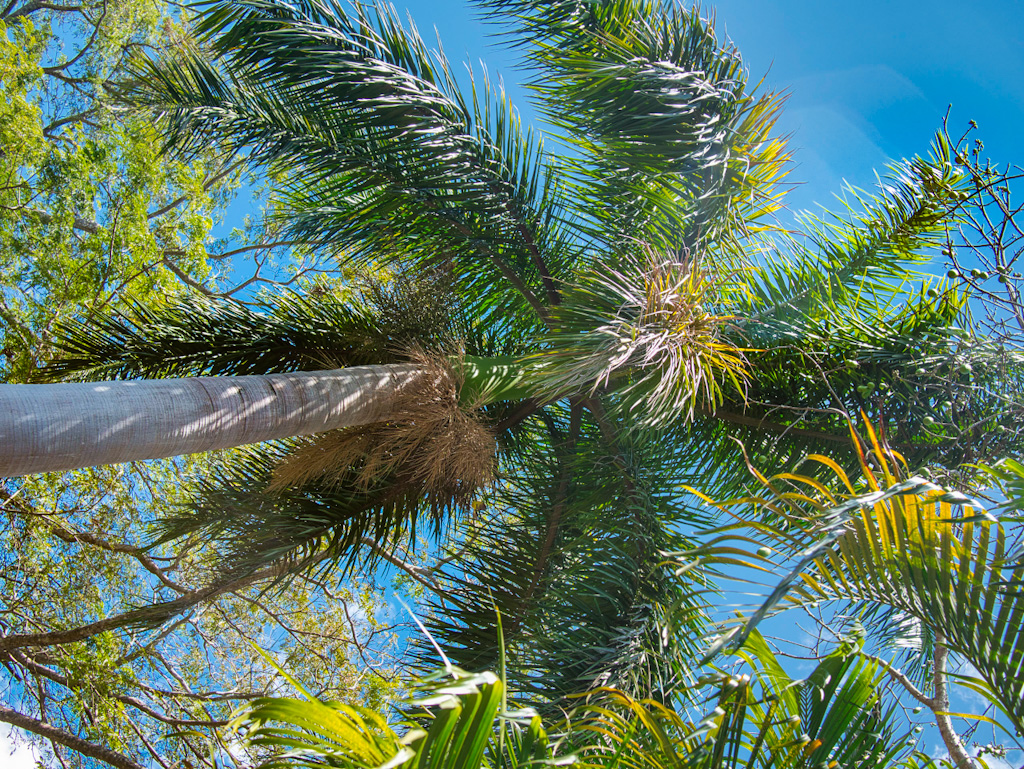
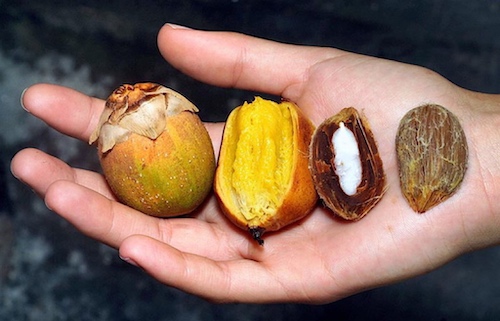
The Wine Palm is a species of palm tree native from Mexico to northern South America. It has a range of uses, supplying edible fruits, seeds, oil and leaves as well as materials for construction. It is commonly harvested from the wild for local use. The apical bud is consumed as vegetable although it will eventually kill the tree. The sap collecting at the base of the removed bud is fermented producing alcoholic beverages. The fruit has a fleshy and fibrous pulp which can be eaten raw with a mildly sweet and nutty flavor. The seeds and the oil it produces can be eaten as well. The seed oil can further be used in making soaps and toiletries. The leaves are widely used for thatching roofs and for weaving. It can also yield fiber that can be used in rope-making and coarse fabrics.
Chilean Wine Palm
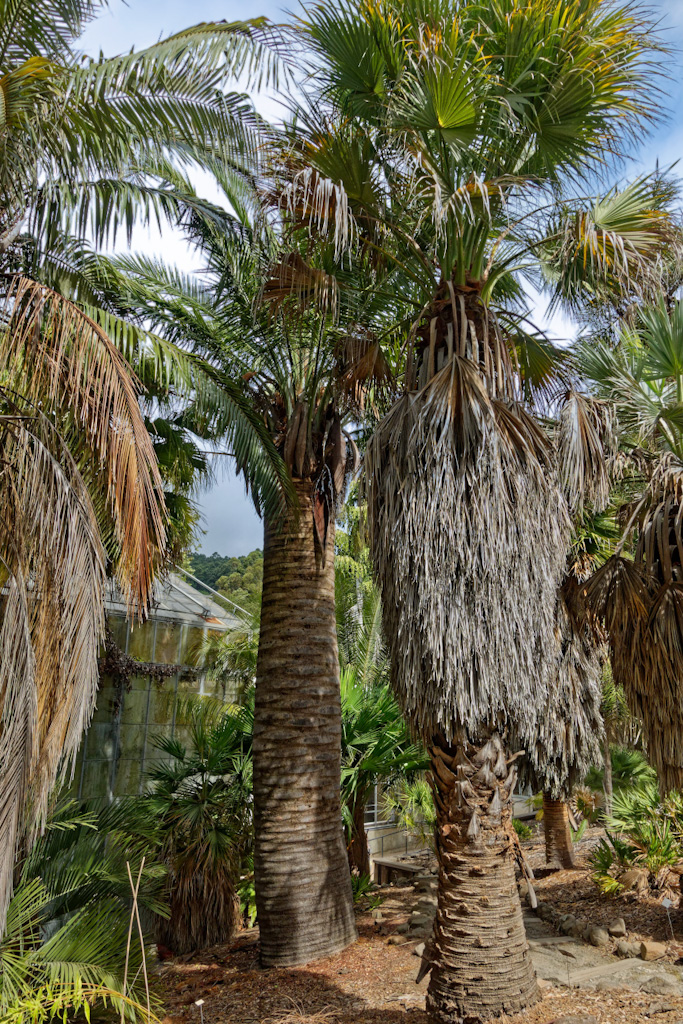
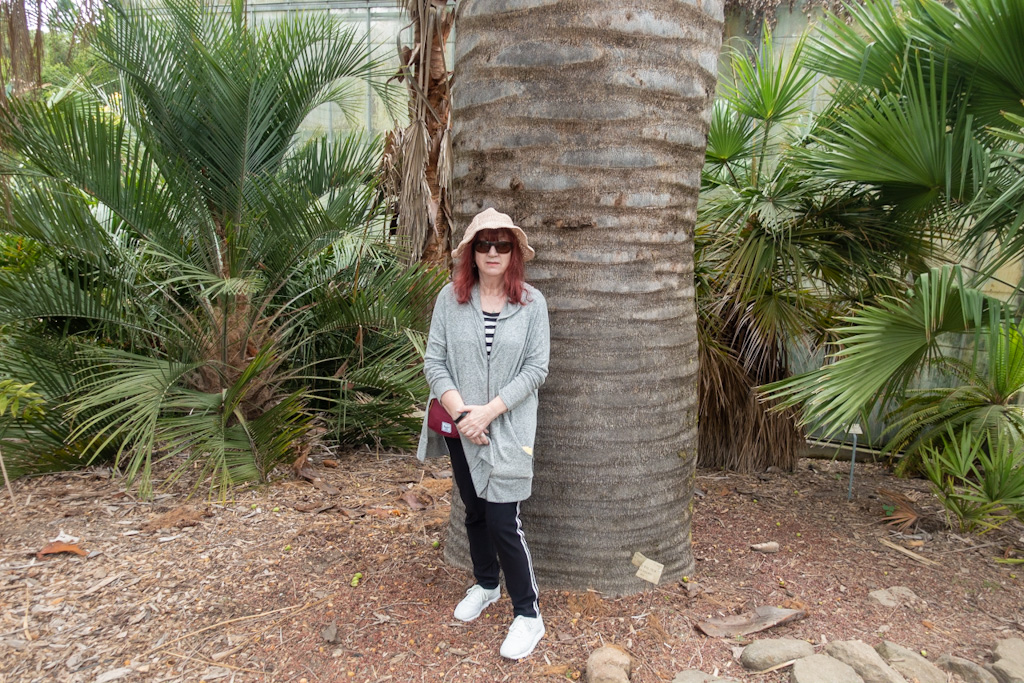
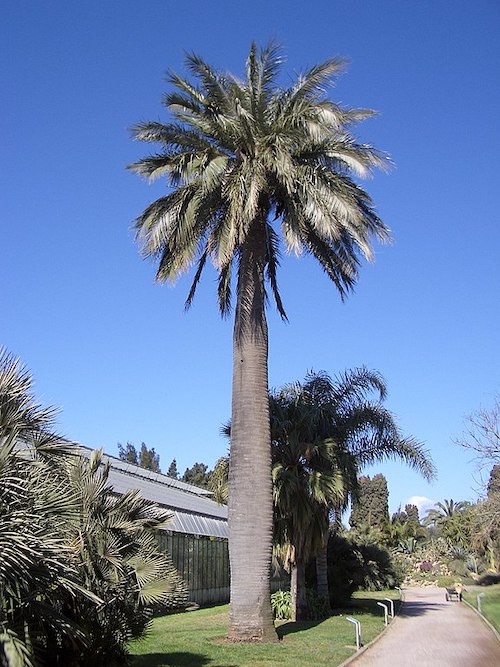
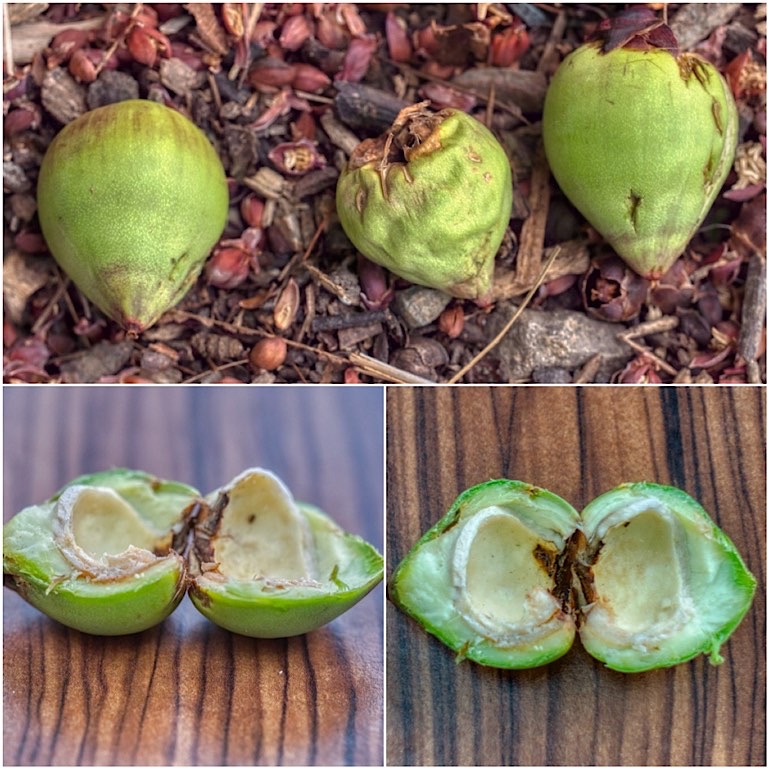
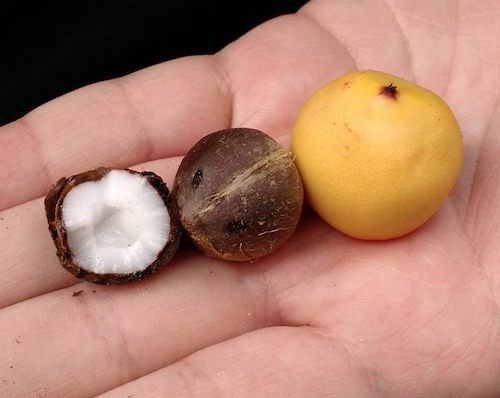
Jubaea chilensis or Jubaea spectabilis, commonly known as the “Chilean Wine Palm” or “Chile Cocopalm” is native to southwestern South America and is endemic to a small area of central Chile. It has long been assumed that the extinct palm tree of Easter Island belonged to this genus as well; however, in 2008, John Dransfield controversially placed it in its own genus, Paschalococos. The 2 inch, oval, egg-yellow, edible fruits hang down in bunches and are fleshy and sweet. Each contains a single hard, smooth-shelled nut about 1–1/2 inches in diameter with an edible kernel, known as coquitos, cokernut or pygmy coconut. The taste is somewhat like a miniature coconut. The watery sap from the trunk is fermented into palm wine, or boiled down into a thick syrup called palm honey, although it kills this very rare and expensive tree. The edible nuts are sold in specialty stores as miniature coconuts or “coquitos.”
Pindo Palm
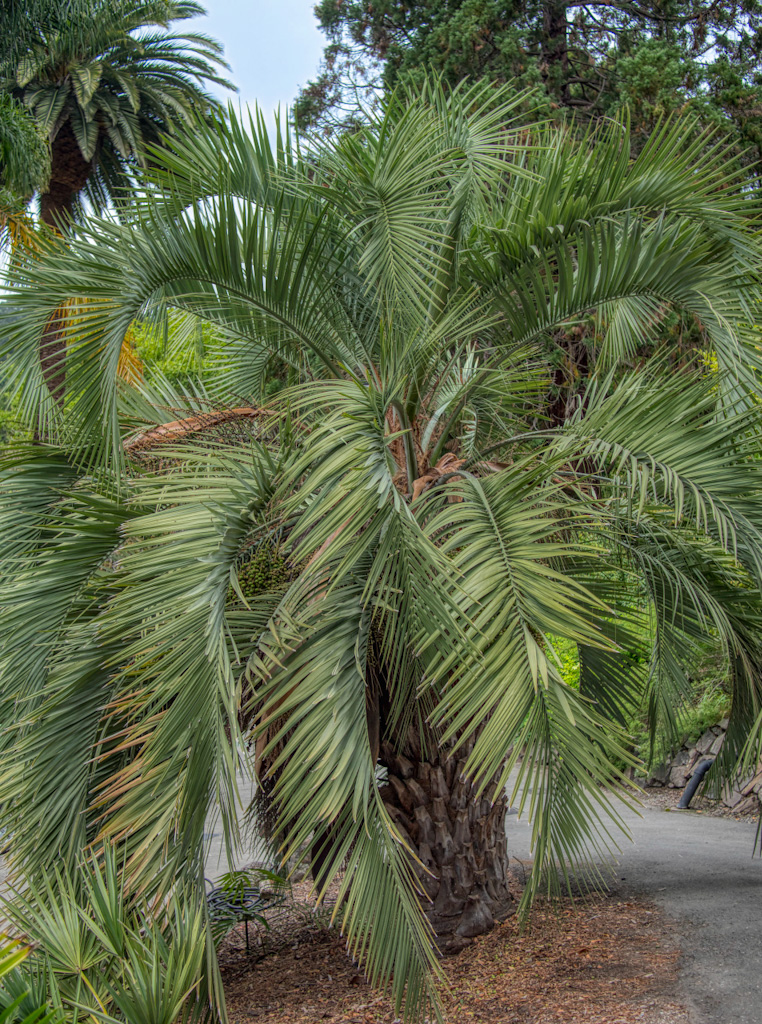
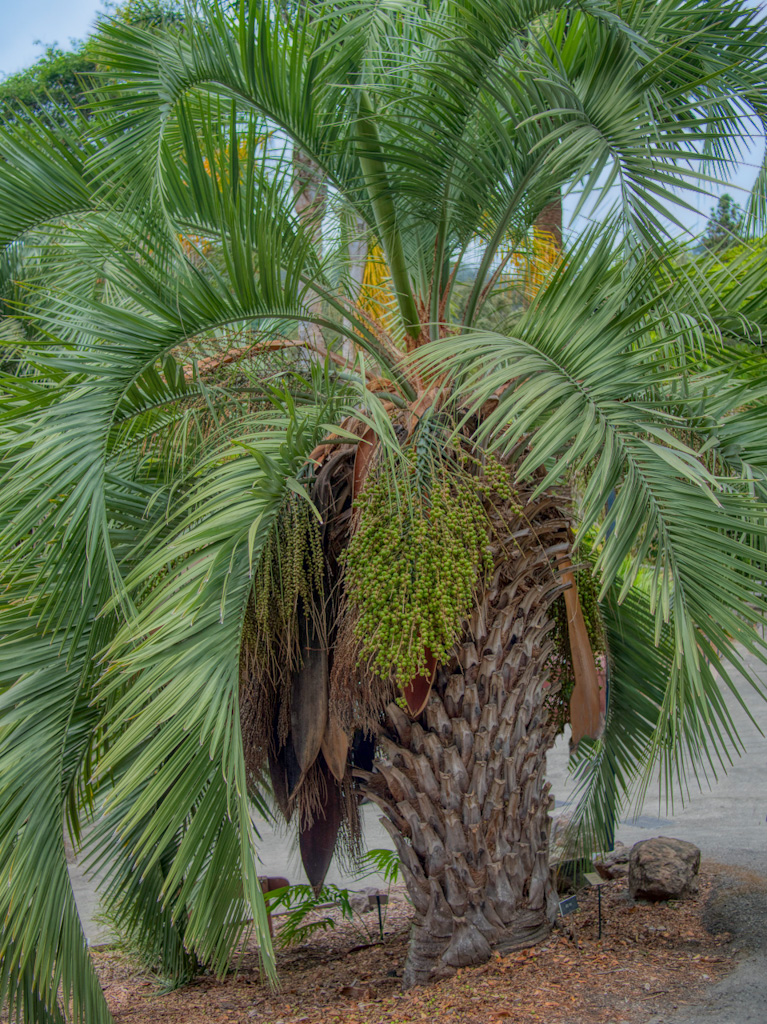
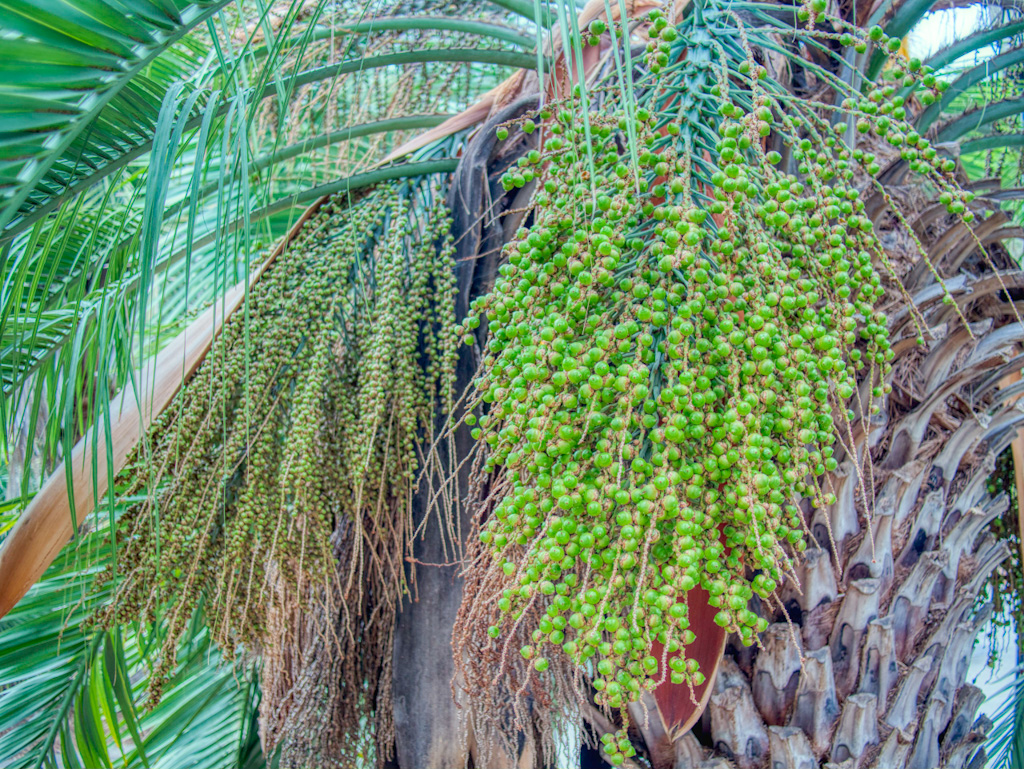
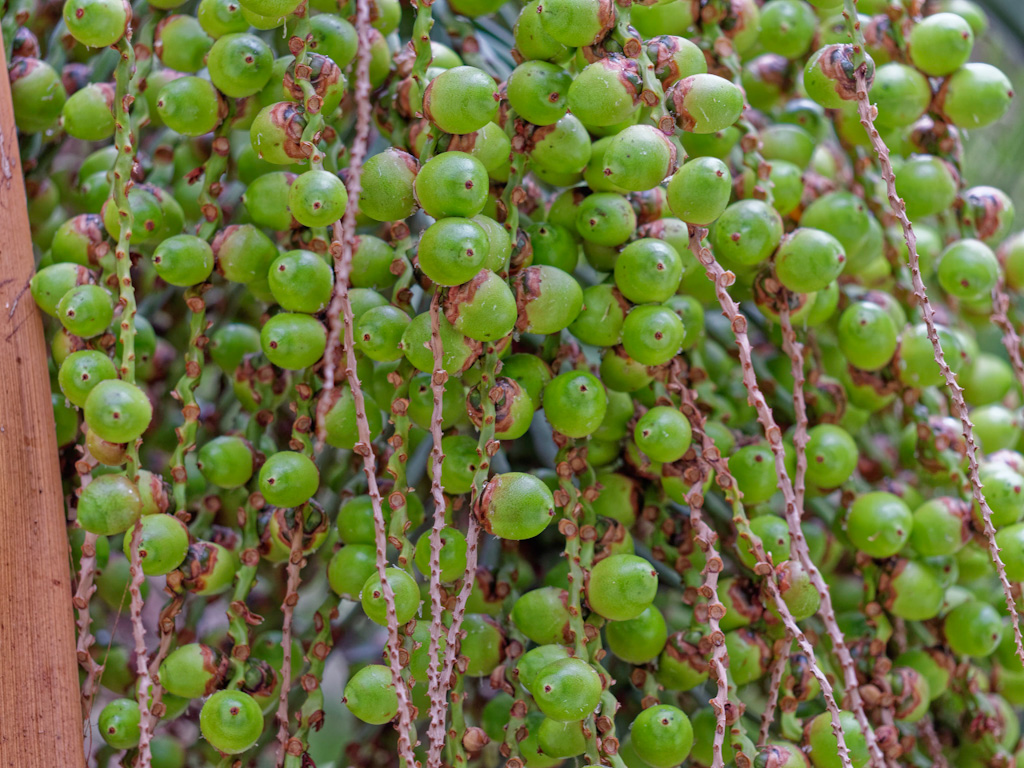
Butia is a small genus of palms containing 9 species, one of which (Butia capitata) is a fairly cold-hardy palm tree and can be grown in the Southeast US. Butia grows natively in Brazil, Paraguay, Uruguay and Argentina. Pindo palms (Butia capitata) are called Jelly Palms because the fruit has a lot of pectin in them. The fruits are locally harvested from the wild between November and February to make juices, liquor, marmalades and ice-cream. The fruit has orange, sometimes red, skin. The pulp is bright orange, highly aromatic, somewhat oily, and quite fibrous. The pulp can be frozen for industrial production. In the north of Minas Gerais state Jelly Palm juice has been added to some public school lunches. An oil can be extracted from the nuts which is quite similar to coconut oil. The fruit is small and fiberous with a big seed, and falls to the ground when very ripe. The taste is a cross between a pineapple and an apricot.
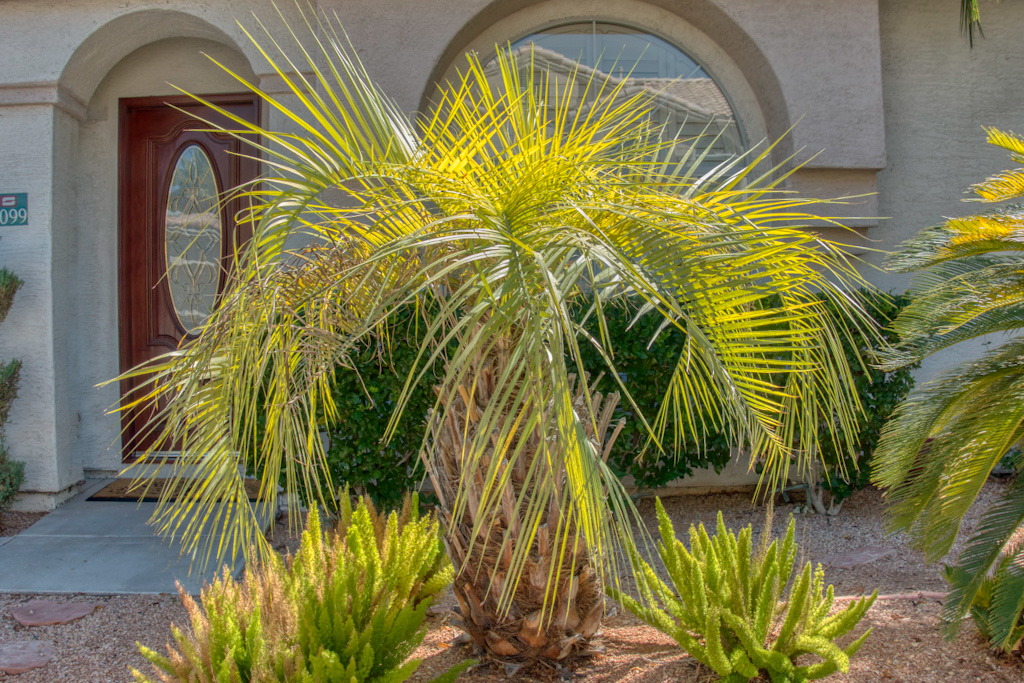
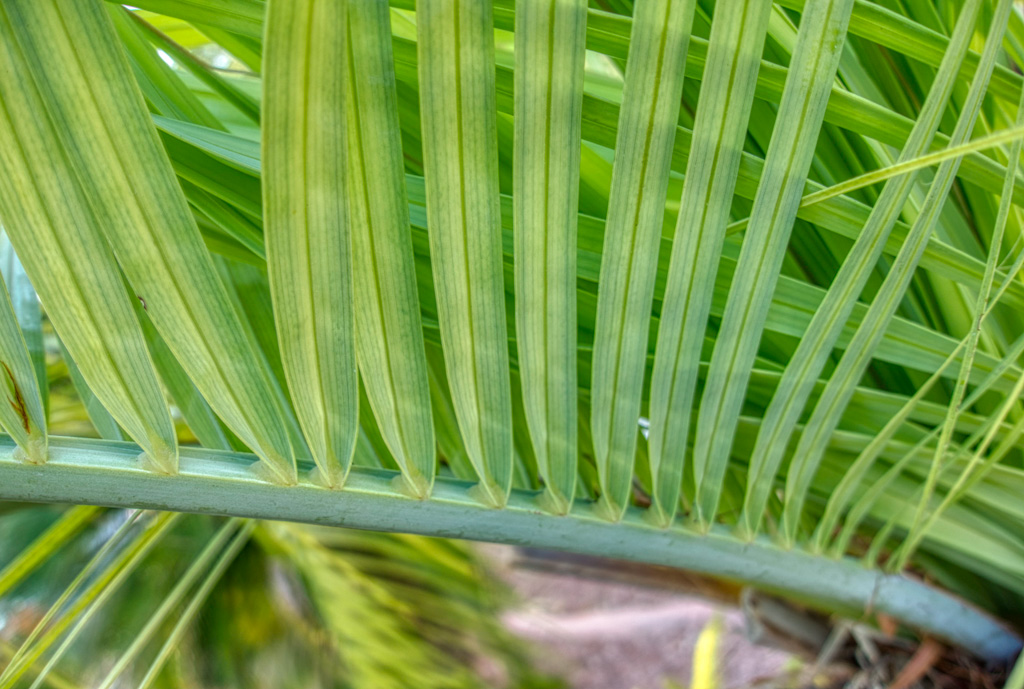
This is a Pindo Palm across from my house in Henderson, a suburb of Las Vegas. You can see it is a little more stressed than the specimen from the Berkeley Botanical Garden possibly due to potassium and/or manganese deficiency. This one has grown very slowly, it is around 10 years old. Palms cultivated around the world under the name Butia capitata are actually all Butia odorata. This small, single-stemmed, feather-leaved palm is widely grown in warmer parts of the US due to its unusual cold tolerance. The palm is slow-growing, eventually reaching 15–20 feet, making it suitable for planting under power lines. Its gray-green recurved leaves are about 4–6 feet long and have leaflets attached to the petioles in a deep V shape. The petioles have spines along their margins. The leaf bases are strongly persistent and give the trunk a distinctive knobby appearance. The 3–4-foot-long flower stalks eventually produce edible 1-inch-diameter yellow to orange fruits.
Bismarck Palm
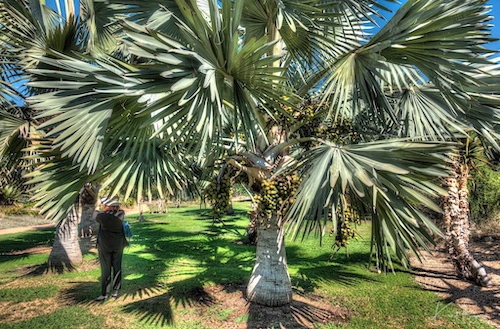
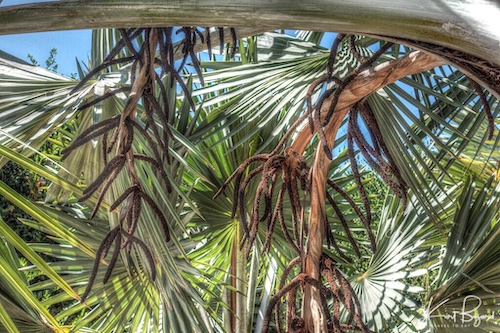
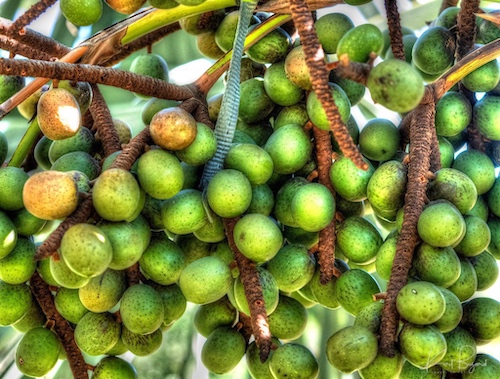
I happened to be at the Los Angeles Arboretum when their collection of Bismark Palms were in fruit and I thought I would include them despite the fact that they are inedible. The Bismarck Palm is native to Madagascar, with a stout trunk and beautiful symmetrical crown of silver fronds. It is a dioecious plant, meaning that there are male and female plants. The fruit of a female Bismarck palm is a yellow-green, maturing to a dark brown-black, and grows in clusters. Male Bismarck Palms will produce long brown inflorescences, but of course will not fruit.
So, as you have seen, palm trees are a significant source of nutrition and materials for many people of the world. As always, I hope you enjoyed the post, I will add more examples in the future as I find them.
References:
All Those Coconut Products & How to Use Them
The Wonderful World of Coconut Products
Edible Palms: An Introduction to Palm Fruits
Identifying Commonly Cultivated Palms
Playing with Washingtonia Palm Fruit
/madagascar-spiny-forest-at-the-la-arboretum-2-of2/
https://www.researchgate.net/publication/276990486_Butia_What_we_think_we_know_about_the_genus

